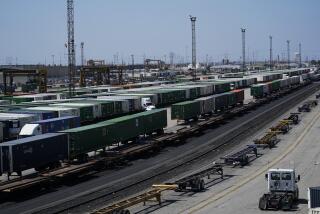Railroads Say Work Rules Are Out of the Steam Era
- Share via
NEW YORK — The nation’s strikebound railroads said Wednesday that oversized train crews and work rules dating to the turn of the century ought to go the way of the men who used to ride cabooses -- into the history books.
Even after racking up healthy profits in recent years, the railroads are hoping to eliminate “people just riding, doing virtually nothing,” in order to better compete with trucking companies that often are quicker and cheaper, said Rush Loving Jr., a spokesman for the Association of American Railroads.
“The union wants two brakemen and an engineer and a conductor,” Loving said. “You can operate with two-man crews -- two people -- an engineer and somebody else up there to work with him.”
The rail unions say any inefficiencies are management’s fault, so it is unfair to blame the workers.
“These companies don’t have a lot of interest in the welfare of the workers. Any way they have to wipe out a worker, wipe out a job, they’ll do it,” said Ed Wytkind of the Railway Labor Executives Association.
“Net income reached a record level in recent years, $2.4 billion in 1988 and $2.2 billion in 1989,” Wytkind said. “What it tells us is that we’re dealing with some very cash-rich companies.”
Both sides agree the railroads have undergone dramatic changes since the days when they were the backbone of the U.S. transportation system. Trains still haul about one-third of U.S. goods and thousands of passengers, although the deregulated trucking industry is claiming a bigger share of the freight business, while airlines have gotten the biggest share of travelers.
The 10 companies affected by the strike employ 230,000 unionized workers, half the number of employees they had in 1980. But the railroads say there are still too many people running most trains.
The railroads also complain that they must pay the crews overtime after they travel 108 miles, just eight miles farther than the standard trip back in 1917.
The industry wants a day’s work classified as 160 miles, Loving said. Other work rules that bother the railroads can often force freight to sit for days until the appropriate workers can come move the cars, Loving said.
Anthony B. Hatch, who follows railroads for PaineWebber, said the power vested in the unions is perhaps disproportionate for the current status of railroads.
More to Read
Sign up for Essential California
The most important California stories and recommendations in your inbox every morning.
You may occasionally receive promotional content from the Los Angeles Times.










